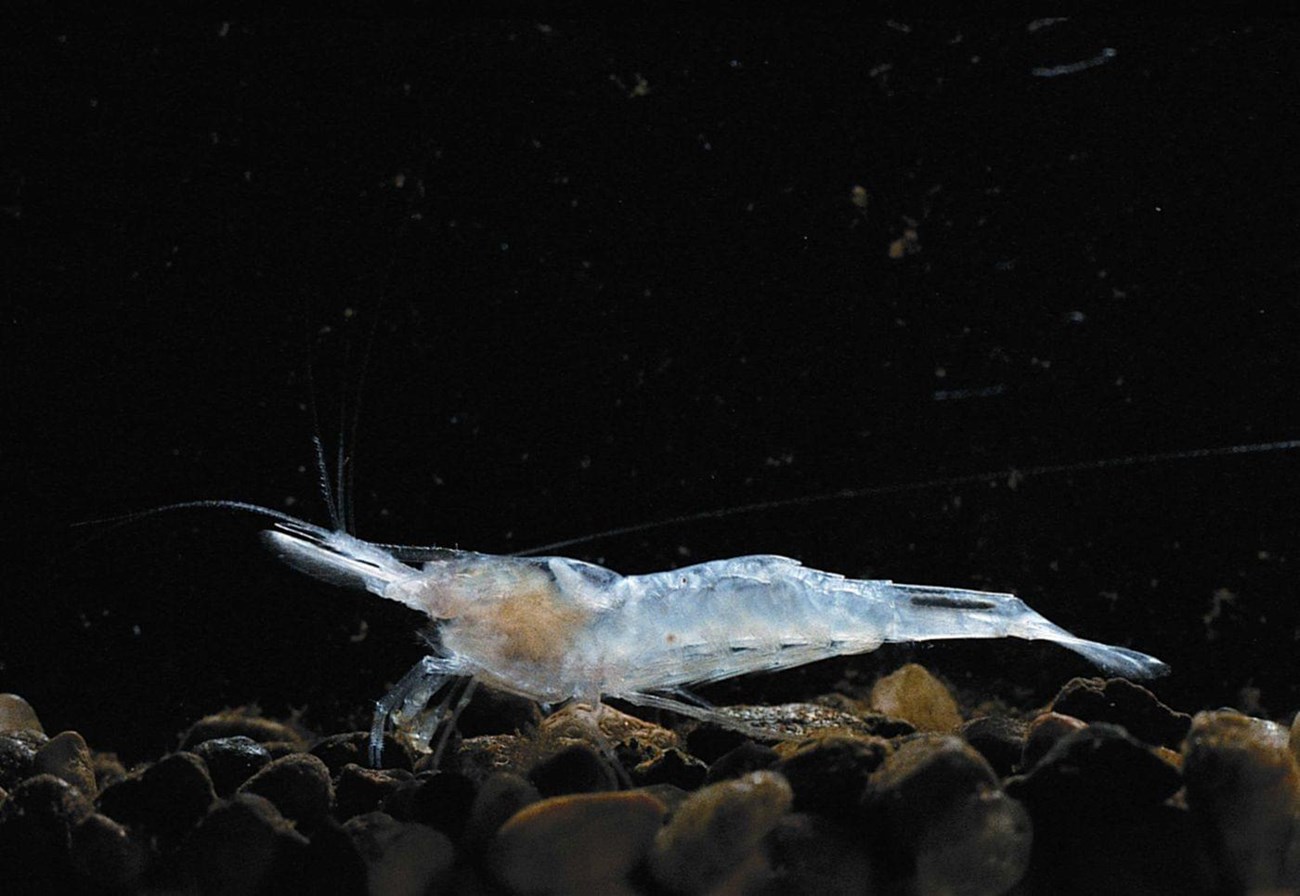Last updated: November 18, 2021
Article
Kentucky Cave Shrimp: Endangered Species of Mammoth Cave

USFWS Photo
These troglobites spend their entire life cycle in the cave. Cave shrimp are specially adapted for this subterranean life, as they have no eyes, and are able to use their two pairs of antennules to taste, touch, and smell their food. They also have no pigment in their shell, making them transparent and incredibly hard to spot. They grow to about 1.25 inches long and are estimated to live for about 10-15 years.

NPS Graphic
Found Nowhere Else
The Kentucky cave shrimp Palaemonius ganteri is a federally endangered, fully cave adapted, freshwater shrimp found only in the immediate vicinity of Mammoth Cave National Park. First described by W.P. Hay in 1901, these shrimp inhabit the lowest level cave passages in ten groundwater basins. Eight of these basins lie wholly or partially in the park and two lie just upstream from the park. The designated critical habitat for Kentucky cave shrimp is the Roaring River in Mammoth Cave, which means that the park along with the US Fish and Wildlife Service (USFWS) is responsible for ensuring the survival of this extraordinary species.
Status as an Endangered Species
One important question with any endangered species is how many of them are there? With cave shrimp, this is a difficult question to answer. Much of their habitat is within completely flooded passages that require special training in the use of SCUBA or rebreather equipment for extended cave diving. In addition to this obstacle, shrimp inhabit passages humans can never access. While we cannot count all the shrimp we can however see trends in the population by monitoring passages accessible without diving. We can also detect the presence of cave shrimp in a given drainage basin by the DNA they release into the water.
In the late 1960s and early 70s the USFWS listed the cave shrimp as endangered when cave biologists could not find any of these tiny crustaceans. Today we can reliably find shrimp in passages that are regularly checked which suggests their population is larger today than it was in the 70s. The hope is that someday the Kentucky cave shrimp will be determined to be no longer in danger of extinction.

NPS Photo
Decline and Habitat Restoration
While we are not certain what caused the decline of cave shrimp, the most likely candidates are pollution, impoundment caused by a dam downstream of the cave on Green River, and unnatural flood pulses caused by releases from a dam upstream of the park. In the 50s when there were no restrictions on disposal of salt water pumped up with oil from wells; much of this brine was dumped into the Green River. This brine may have eventually contaminated cave rivers, while water usually flows out of Mammoth Cave’s springs into the Green River, water also reliably flows backwards into the springs during flooding events, bringing contaminants into the cave. Sewage, agricultural runoff, parking lot and highway runoff, spills, and industrial waste are other contaminants that have entered cave streams either from the Green River or from land inside or beyond the park. Since then, water quality has improved a great deal due to State and Federal regulations requiring:
-
reinjection of oil well brine back where it came from
-
improved sewage treatment
-
agricultural and industrial reforms
-
highway runoff/spill catchment basins
-
parking lot filters
Further improvements have been a result of negotiations between The Nature Conservancy and the US Army Corps of Engineers which led to an agreement that restored flood pulses in the Green River to more natural patterns. Finally, in 2016 Lock and Dam #6, downstream of Mammoth Cave, washed out and was later fully removed, locally restoring natural water flow in the Green River.
Ecology
Kentucky cave shrimp do not live in isolation. They are part of a specialized biological community that lives mostly in the lowest cave streams. Microbes are the foundation of the food web and they form a biofilm on underwater cave surfaces. The shrimp, along with tiny cave adapted crustaceans, flatworms, and snails graze on these biofilms. Predators such as cave adapted crayfish and cavefish feed upon these grazers. Learn more about this complex aquatic ecosystem.
